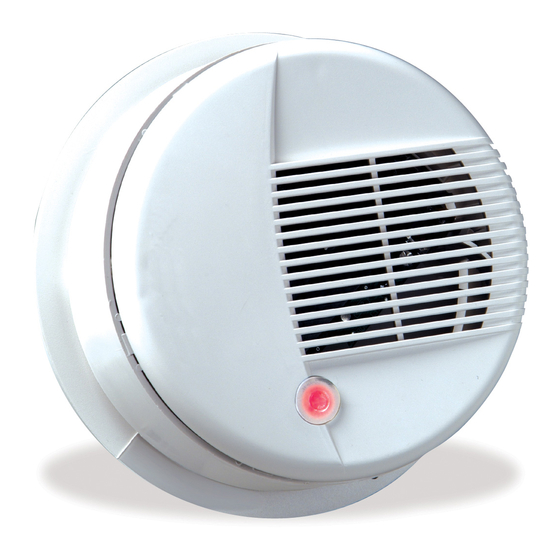- ページ 2
煙警報器 DSC AMS-220TのPDF 取付・取扱説明書をオンラインで閲覧またはダウンロードできます。DSC AMS-220T 4 ページ。 Addressable smoke detector dsc ams-220/220t

How the Smoke Detector Works
As shown in the illustration, a light source is directed across the
smoke chamber and is not normally reflected into the sensing
element. When smoke enters the chamber, the light beam is scattered
by the smoke and is reflected into the sensor. When enough light is
detected by the sensor, an alarm is activated.
Normally, light pulses in the Smoke Chamber
do not reach the light sensor
The control panel checks the devices routinely to monitor any
alarm or trouble condition. If the device's power is too low, it will
send a low power trouble to the control panel.
The AMS-220/220T is programmed to test its sensitivity every 45
seconds. If the sensitivity is too low, it will send a low sensitivity
trouble to the control panel.
Normally the indicator light pulses every 45 seconds. When smoke
is detected, the indicator light flashes rapidly and a smoke alarm
signal is sent to the control panel. When the smoke clears the
detector automatically resets, however the control panel will remain
in alarm until an access code is entered at a system keypad.
When a high temperature is detected, the indicator light continues
to pulse once every 45 seconds and a heat alarm signal is sent to
the control panel. The control panel will remain in alarm until an
access code is entered at a system keypad. The detector resets
automatically when the temperature goes below 135°F/57°C.
Limitations of Smoke Detectors
While the AMS-220/220T Smoke Detector has been designed for
reliability, it is important to know that all smoke detectors have
limitations.
• Smoke detectors will not work without power. Devices powered
from a control panel will not function if the control panel's AC and
battery backup power supplies both fail.
• Smoke detectors can only generate an alarm when smoke gets
inside the smoke chamber; anything that prevents smoke from
entering the smoke chamber may prevent or delay an alarm.
Refer to the 'Guidelines for Locating Smoke Detectors' on this
Instruction Sheet ; smoke detectors should be located on at least
every floor of the premises, preferably in every room. It is also
important to avoid obstructions, such as closed doors, that may
prevent smoke from reaching the unit. A smoke detector will not
detect a fire in the walls, in the chimney or on the roof of a building
until smoke enters the smoke chamber.
• Smoke detectors have certain obvious limitations: they may not
provide protection for someone smoking in bed, for children
playing with matches, or for sudden and violent explosions. A
smoke detector is a single part of overall fire safety precautions.
The smoke detector should never be seen as a substitute for a
complete fire safety program.
Smoke in the Smoke Chamber deflects light
into the light sensor, triggering an alarm.
Guidelines for Locating Smoke Detectors
On smooth ceilings, detectors may be spaced 9.1m (30 feet) apart
as a guide. Other spacing may be required depending on ceiling
height, air movement, the presence of joists, uninsulated ceilings,
etc. Consult National Fire Alarm Code NFPA 72, CAN/ULS-S553-
M86 or other appropriate national standards for installation
recommendations.
Do not locate smoke detectors at the top of peaked or gabled
ceilings; the dead air space in these locations may prevent the unit
from detecting smoke.
Avoid areas with turbulent air flow, such as near doors, fans or
windows. Rapid air movement around the detector may prevent
smoke from entering the unit.
Do not locate detectors in areas of high humidity.
Do not locate detectors in areas where the temperature rises above
38
o
C (100
o
F) or falls below 5
Smoke detectors should always be installed in accordance with
NFPA 72, the National Fire Alarm Code. Smoke detectors should
always be located in accordance with:
• Paragraph 2-2.1.1.1 of NFPA 72, Chapter 2.: "Smoke detectors
shall be installed outside of each separate sleeping area in the
immediate vicinity of the bedrooms and on each additional story
of the family living unit, including basements and excluding crawl
spaces and unfinished attics. In new construction, a smoke
detector also shall be installed in each sleeping room."
• Paragraph 2-2.1.1.2 of NFPA 72, Chapter 2.: "Split level
arrangement. Smoke detectors are required where shown. Smoke
detectors are optional where a door is not provided between living
room and recreation room."
Owner's Maintenance Instructions
The AMS-220 Smoke Detector is designed to require a minimum of
maintenance. If the case becomes dusty, wipe the case gently with
a soft dry cloth. If the case is greasy, wipe it gently with a soft cloth
slightly dampened with soapy water.
Never disassemble the smoke detector. There are no user
serviceable parts inside the unit. Never paint the unit, as paint
may prevent smoke from entering the unit. If you are planning
renovations or repainting, contact your Installer and ask that
the unit be temporarily removed until work is complete.
If the unit is located in an area where it is exposed to high levels of
dust or insects and is found to cause false alarms, it may require
service; contact your smoke detector installer or dealer.
o
C (41
o
F).
